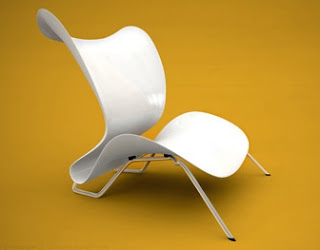Paper Fractals
 Of course Platonic geometry will always be an endless source of inspiration. To be honest, I prefer objects with simple geometric forms that are well balanced and developed from simple grids. The problem is that we normally use 2D grids only to extrude 3D objects. I mean, our mental process for developing a volume is very similar to how volumes are created using CAD. That's how our minds have been trained since we were kids. For many years during pre-school and primary school, kids spend more time with crayolas, making 2D drawings that their parents put on their refrigerators, rather than making 3D objects with meccano or building blocks. I guess it's because there's no way of hanging those things on fridge's doors!
Of course Platonic geometry will always be an endless source of inspiration. To be honest, I prefer objects with simple geometric forms that are well balanced and developed from simple grids. The problem is that we normally use 2D grids only to extrude 3D objects. I mean, our mental process for developing a volume is very similar to how volumes are created using CAD. That's how our minds have been trained since we were kids. For many years during pre-school and primary school, kids spend more time with crayolas, making 2D drawings that their parents put on their refrigerators, rather than making 3D objects with meccano or building blocks. I guess it's because there's no way of hanging those things on fridge's doors!So, our mind will start thinking 2D, instead of shifting to 3D mode when we start an idea. It's not after many years of re-programming our brains to think in three dimensions, that we can actually "build" our ideas in 3D. But still, ... trying to find and develop full geometric 3D grids in our minds is something for aliens from outer space. Imagine you are sketching something on paper in isometric view (as it should always be done)... usually, if we try to apply a simple geometric pattern, let's say a 2 way curved surface, we will draw it in paper just like we would do it on a computer: we'll draw both curves on the corresponding planes and then just drag the points to make our 2 directional curvature. I bet there's only a few people who can actually imagine and fully master a geometric 3D grid mentally. That's why CAD has become a quite interesting tool. CAD programs that work in 3D mode allow us to explore directly on a 3D object without being concerned on how the geometry behaves on a 2 dimensional level.
 Yes, CAD is a very powerful augmentative tool for designers, but not everyone actually takes advantage of that. Most of what we see in industrial design is once again a case of "designer's dogs bollocks syndrome" i.e. most of the shapes and forms we see in objects are geometries created just by adding tools and "filters"... not many are actually created by a deliberate act of design. Parts are organized by tools such as "distribute equally" instead of actually being on a certain place determined by a pre-determined geometrical grid. On the other hand, the traditional methods for exploring
Yes, CAD is a very powerful augmentative tool for designers, but not everyone actually takes advantage of that. Most of what we see in industrial design is once again a case of "designer's dogs bollocks syndrome" i.e. most of the shapes and forms we see in objects are geometries created just by adding tools and "filters"... not many are actually created by a deliberate act of design. Parts are organized by tools such as "distribute equally" instead of actually being on a certain place determined by a pre-determined geometrical grid. On the other hand, the traditional methods for exploring  2 and 3 dimensions are not so simple, only a few can transform a 2D surface into a clever designed 3D object, like this origami spoon by Michael Sholks... and this kind of skill requires a very hard mind training, we just think that computers are easy to use, and any dummy can create a 3D object given a simple software training... well, that's wrong. Yes, any monkey can type into a keyboard or a typing machine and some letters will eventually appear... but that doesn't make the monkey a Shakespeare... a Pulitzer prize maybe.
2 and 3 dimensions are not so simple, only a few can transform a 2D surface into a clever designed 3D object, like this origami spoon by Michael Sholks... and this kind of skill requires a very hard mind training, we just think that computers are easy to use, and any dummy can create a 3D object given a simple software training... well, that's wrong. Yes, any monkey can type into a keyboard or a typing machine and some letters will eventually appear... but that doesn't make the monkey a Shakespeare... a Pulitzer prize maybe.Anyway... maybe we still have to learn the thinking skills necessary to take full advantage of technologies such as CAD. We'll have to teach kids how to think in 3 or 4 dimensions (yes, including time as a dimension in a product / object life span) before their minds get stuck in a 2 dimensional universe of extruded objects. Maybe teaching them fractal mathematics in highschool could result in more interesting patterns of thinking than the usual algebra or trigonometry. Take for example these fractal sculptures and objects by Richard Sweeney.
ciao






























0 Comments:
Post a Comment
<< Home